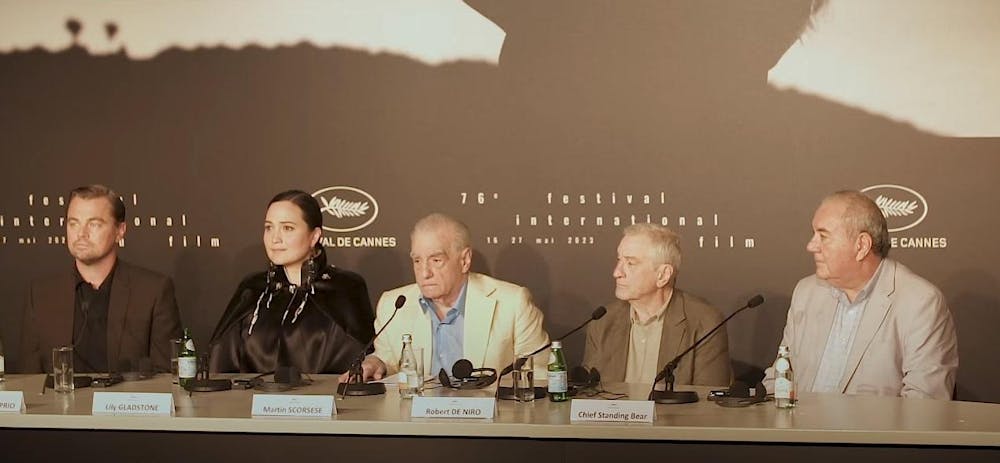In a solemn gathering, the Osage people bury a ceremonial pipe and declare that their children will now speak the white man’s language and be raised in the white man’s culture. Shortly afterward, the Osage are seen celebrating as oil gushes from the ground. As filmmaker Martin Scorsese foreshadows, this black gold, which according to the film made the Osage the richest people per capita in the world, also brought the attention of those who sought to exploit them by whatever means possible. “Do you see the wolves in this picture?” asks Ernest Burkhart (Leonardo DiCaprio), reading aloud from a children’s picture book on the Osage people. As the film cuts to a scene of Ernest and his brother robbing and looting the Osage people, it is clear who these wolves are.
In “Killers of the Flower Moon,” Scorsese’s latest film, the audience follows Ernest and his uncle William “King” Hale (Robert De Niro), who plots to have Ernest marry a wealthy Osage woman, Mollie Kyle (Lily Gladstone) and murder her relatives to inherit her headrights to the oil reserves located in Osage territory. Based on the real story of W. K. Hale, covered in a 2017 David Grann book of the same name, Scorsese paints a damning image of the historical treatment of the Osage people by their white “guardians,” who controlled their finances and orchestrated the Reign of Terror from 1910 to 1930, killing an estimated 60 Osage people for their headrights. While most of these murders went uninvestigated, the deaths of Mollie’s sisters, mother, and other relatives prompted an investigation from the FBI. Whereas the story of the Osage murders could have turned into a typical Western, Scorsese experiments with genre norms by framing the entire narrative around the romance and marriage of Ernest and Mollie and interspersing scenes of familial life with depictions of Ernest and Hale’s heinous acts.
Mollie’s doomed marriage to Ernest is what elevates “Killers of the Flower Moon” to the next level. Starting off as her taxi driver and eventually marrying her, Ernest seems to care, to some extent, about his wife but simultaneously assists his uncle and brother in killing her relatives. DiCaprio masterfully portrays this character as cowardly, gullible, and greedy. His performance leaves audiences wondering how Ernest could possibly claim to love Mollie while committing such despicable deeds. Throughout the movie, audiences know that the main mastermind is Hale, and De Niro’s interpretation of this double-faced man, who claims to be the benefactor of the very people he kills, is what defines the tense relationship between Ernest and Hale — pawn and manipulator.
The standout performance in this film, however, is by Gladstone, whose character Mollie has to watch her family die one by one while unknowingly being poisoned by her husband under the guise of insulin injections for diabetes. “Killers of the Flower Moon,” despite being narrated from Ernest’s perspective, is ultimately a story about Mollie and the Osage people. Gladstone pulls us into the tragedy of this story. Mollie’s pained cry at realizing her last remaining sister’s house has been blown up, her reaction to Ernest’s confession to murdering her family, and her pleas to the President to help the Osage — Gladstone’s performance is what grounds the Reign of Terror in reality and displays how brutally agency was stolen from the Osage people.
Scorsese’s cinematography allows the plot to progress efficiently and seamlessly. The movie opens with a TV report of newfound oil on Osage land and Ernest arriving home from World War I, then transitions to scenes exemplifying the Osage people’s wealth without skipping a beat. Scenes with Ernest, his brother Byron, and other moonshiners and criminals are dark and grainy, whereas the reunions and meetings within the Osage are characterized by the bright colors of their clothing and jewelry. One of the most striking scenes is the death of Mollie’s mother Lizzie from “wasting disease,” (in reality, poison) where she shuts her eyes and opens them to see her ancestors beckoning her to accompany them into a lush green environment — perhaps one of the only truly hopeful scenes in the movie. Across its long three-and-a-half-hour runtime, “Killers of the Flower Moon” has no scenes that lag or bore the audience, and for me, those three-and-a-half hours went by fast.
In addressing this important historical event, Scorsese and his team worked to ensure that Osage representation was accurate by involving community members in costume design, character styling, sets, and music. To quote Scorsese, “Every possible aspect with every scene with the Osage had to be dealt with people from the Osage Nation.” This was echoed by the Osage Nation’s Principal Chief. Some critics believe that the film lacked enough screen time and contribution from the Native actors, and it certainly could have elaborated more on the laws that permitted the exploitation of the Osage and centered Mollie’s character more in the film. But as it stands, “Killers of the Flower Moon” is a powerful and tragic depiction of a particularly brutal period of American history.
Aaryan Jagtap is a contributing writer for The Prospect from Mumbai, India. He can be reached at aaryanjagtap@princeton.edu.








